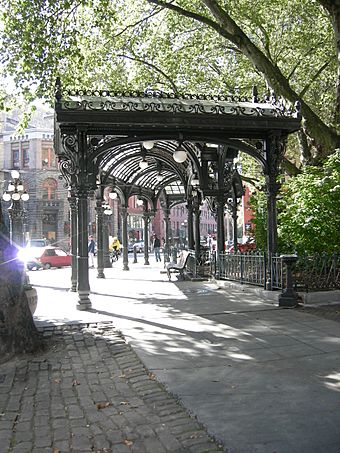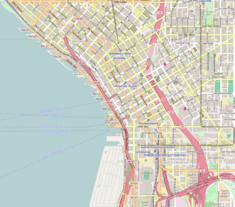Pioneer Square pergola facts for kids
|
Pioneer Square Pergola
|
|
|
U.S. Historic district
Contributing property |
|

Looking west at the pergola, 2007
|
|
| Location | 1st Avenue and Yesler Way Seattle, Washington, U.S. |
|---|---|
| Built | 1909 |
| Architect | Julian F. Everett |
| Restored | 1972, 2001 |
| Part of | Pioneer Square–Skid Road District (ID70000086) |
| NRHP reference No. | 77001340 |
Quick facts for kids Significant dates |
|
| Added to NRHP | May 5, 1977 |
| Designated NHL | May 5, 1977 |
| Designated CP | June 22, 1970 |
The Pioneer Square Pergola is a cool structure made of cast iron and glass. You can find it in Pioneer Square, a park in Downtown Seattle, Washington, United States. It was built way back in 1909. Its main job was to give shelter to people waiting for cable cars. These cable cars ran on the James Street and Yesler Way lines.
The pergola is located where 1st Avenue and Yesler Way meet. In 1977, it became a National Historic Landmark. It shares this special title with the nearby Pioneer Building and a totem pole.
When it was first built, the pergola also had an underground public bathroom. This bathroom closed in the 1940s when the cable car service stopped. Over time, the pergola started to fall apart. The city fixed it up in 1972. But then, in 2001, a semi-truck crashed into it and destroyed it! It cost $3.4 million to rebuild it completely. The new pergola has been made stronger to protect it from future crashes.
Contents
What is the Pioneer Square Pergola?
The Pioneer Square Pergola looks like something from the Victorian era. It has a triangular shape and was designed by Julian F. Everett, a local architect. When it first opened, it was known as a "comfort station" because of its public bathroom.
The pergola is about 60 feet (18 meters) long and 16 feet (5 meters) tall. It stands on many iron columns. It used to have fancy iron decorations and a glass roof. The underground public bathroom opened on September 23, 1909. It cost $24,000 to build, which was a lot of money back then!
This bathroom was one of the first underground public restrooms in Seattle. It was very fancy, with nice floors and fixtures. It had many stalls for both men and women. Some people thought the bathroom was an ugly addition to the park. As cable car service ended, the pergola became run down. By the late 1940s, parts of it were taken away. The bathroom closed in 1948.
Restoring and Rebuilding the Pergola
In 1972, the pergola got a big makeover. A man named James E. Casey, who started United Parcel Service (UPS) in Pioneer Square, gave $100,000 for the repairs. Workers used the original plans to rebuild the roof and light fixtures. The restoration started in July 1972 and finished in February 1973. The underground bathroom was not fixed during this time.
Sadly, the renovated pergola started to wear out quickly. It had to be closed and repaired again in 1992. This repair cost another $100,000 because some bolts from the earlier work had rusted.
Then, on January 15, 2001, a large semi-truck crashed into the pergola. The truck was making a sharp turn and hit the structure, destroying it. Because the pergola was a city landmark, the city promised to rebuild it. The trucking company took responsibility and paid $1 million to help rebuild it.
The company Seidelhuber Iron and Bronze Works rebuilt the pergola. They used parts of the damaged structure to guide their work. The project cost $3.4 million. It was a difficult job, made even harder by an earthquake in February 2001. This earthquake caused the roof of the underground restroom to sink a bit.
The new pergola was built with a strong steel frame inside. This helps prevent it from collapsing again. The twelve Corinthian columns and sixteen arches were rebuilt using iron from the original structure.
Protecting the Pergola
The rebuilt pergola officially reopened on August 17, 2002. The total cost was $3.9 million. Because vehicles kept hitting the pergola, the city added strong poles and bollards around it. These bollards are like short, sturdy posts that stop vehicles. They successfully stopped two semi-trucks in 2008 and 2012, preventing more damage.
However, the pergola has still faced some challenges. In 2013, it was hit twice: once by a semi-truck and once by a driver who left the scene. These incidents damaged the iron fence around the structure.
In February 2014, Seattle Seahawks fans were celebrating their Super Bowl XLVIII victory. Some fans climbed onto the pergola and broke twenty of its glass roof panes. Seahawks fans and businesses later raised $25,000 through crowdfunding to pay for the repairs. To prevent future damage, a temporary fence was put around the pergola before the team's next Super Bowl appearance in 2015.
Images for kids




